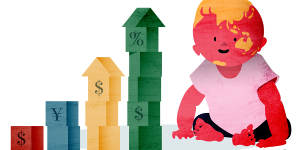
Women face a prolonged and significant “motherhood penalty” after having children.Credit:Matt Davidson
Children can be a joy,but they don’t come cheap. Beyond childcare,schooling,food and clothes,children have an economic impact on the wages and careers of parents – particularly mothers.
But children are important to the economy – they’re the future taxpayers,innovators and workers the country needs.
So there are different costs and benefits to having children,depending on whether you’re a mother,a family,or the country more broadly.
Georgie Dent,chief executive of The Parenthood,said the federal government had done some important work,including expanding access to subsidised childcare,but more was needed to address the pressures on working families.
Loading
More than half of the working family survey respondents (60 per cent) said that having more control over when and where they worked would be a good way of supporting working parents and carers,while 51 per cent said they’d be more supported by reduced job pressures and workloads.
Three-quarters of parents agreed with a statement that if they looked for another job,they would not apply for one that did not offer flexible work arrangements.
Nearly a third of women and a quarter of men agreed they “would take a 10 per cent pay cut if it meant my workplace would adopt/continue to offer flexible working arrangements”.
Angerer was made redundant about six months after returning from maternity leave following the birth of her son,now aged two.

There are risks to the economy from falling fertility rates.Credit: Matt Davidson
Now on maternity leave with her one-week-old daughter,the digital marketing and communications professional says she had been conscious when searching for a new job of finding a family-friendly workplace.
“I definitely felt the pressure to make a decision on my next role based on the flexibility that I would need as a mum rather than my career ambitions,” she says.
The cost to the country:Dangers of depopulation
The costs and benefits of children to women and families relate to a broader issue. The world economy has surfed a demographic wave for the best part of two centuries.
Scientific advances,medical breakthroughs (penicillin was discovered just ahead of World War II),improved safety at home and in workplaces,the advent of sewerage systems and refrigeration,plus the shift away from manual labour,all mean a child born today can look forward to a lifespan exceeding 80 years.
In 1900,the average lifespan of an Australian was under 50 years.
More consumers,and more wealthy consumers,have driven economic development to unparalleled levels.
Loading
But this demographic wave is now crashing across the world’s richest nations and,outside a handful of largely poor African nations,the rest of the world.
Last year’s intergenerational report noted that population ageing was one of the major forces that will shape the nation’s future.
“An ageing population presents long-term economic and fiscal challenges,with fewer people of working age relative to the number of older Australians and growing demand for quality care and support services,” it noted.
The age pension,for instance,is the single largest federal budget expense and is forecast to top $61 billion in the coming financial year. Aged care services for older Australians will reach $36 billion.
Combined,the pension and aged care will account for a fifth of total government spending. And that proportion is only expected to increase.
That means the taxes of a relatively smaller working population have to cover the cost of supplying services to an increasing number of people in non-tax-paying retirement. About 40 per cent of the expected increase in extra government spending over the next four decades is forecast to be due to the ageing of the population.
Apart from costs associated with ageing,more economists now believe productivity and innovation are slowing as the population greys.
An influential paper by American economists Nicole Maestas,Kathleen Mullen and David Powell in 2022 found that for every 10 per cent increase in the proportion of America’s population above the age of 60,there was a 5.5 per cent fall in GDP per capita.
A third of the drop was attributable to slower employment growth,the rest was due to a slowdown in productivity growth.
In the past fortnight,both Treasurer Jim Chalmers and his shadow,Angus Taylor,have acknowledged there are issues with Australia’s falling fertility rate. Both,however,have ruled out returning to thebaby bonus used by the Howard government to encourage couples to have more children.
Loading
There was an increase in the fertility rate following the introduction of the baby bonus. Australia’s fertility rate had fallen to a record low of 1.71 in 2001 and remained around that level until 2005.
By 2008 it had reached 2.02 – still short of the 2.1 replacement level,but a sharp increase over the 2001 level.
Demographers continue to argue about whether this increase was driven by the baby bonus or something else,such as a demographic “echo” from younger members of Generation X who started having children.
The increase in fertility disappeared when the global financial crisis struck in 2008. And it kept falling through the 2010s to now sit at 1.63.
It’s not just Australia.
The de-population now under way in China may have an even larger impact on Australia.
China’s fertility rate is just 1.1. Last year,its population shrank by 2.2 million,following an 800,000 drop the previous year. The country’s median age is now above 40 and rapidly climbing.
Over the next decade,up to 300 million Chinese workers now in their 50s are expected to leave the workforce. This group,born before the “later,longer,fewer” campaign of the early 1970s and then the notorious one-child policy,are by far the largest age cohort in the nation.
Loading
Not only will China’s population be much greyer,it will be far smaller. The largest de-population of a nation in history is forecast,as China shrinks from almost 1.3 billion to around 700 million by 2100.
Without China’s demand for Australian resources since the turn of this century,the story of Australia’s economic performance over the past two decades would be vastly different. Australia would simply be much poorer.
A China with a shrinking population needs less in the way of natural resources (such as Australian iron ore,coal and LNG). A fall in demand also means lower prices,which feed into company profits and company taxes.
Countries have been scrambling to encourage women to have more children as their birth rates plummet below the rate of replacement.
But Angerer says any similar policies would not have swayed her family plans.
“It’s all well and good to have government policy around having more kids because we need more taxpayers,but ultimately ... if you’re not going to support those families to actually raise those children by providing affordable childcare,and also enabling workplaces to be truly flexible when those children are growing up and being educated,then there’s no point,” she says.
Cut through the noise of federal politics with news,views and expert analysis.Subscribers can sign up to our weekly Inside Politics newsletter.